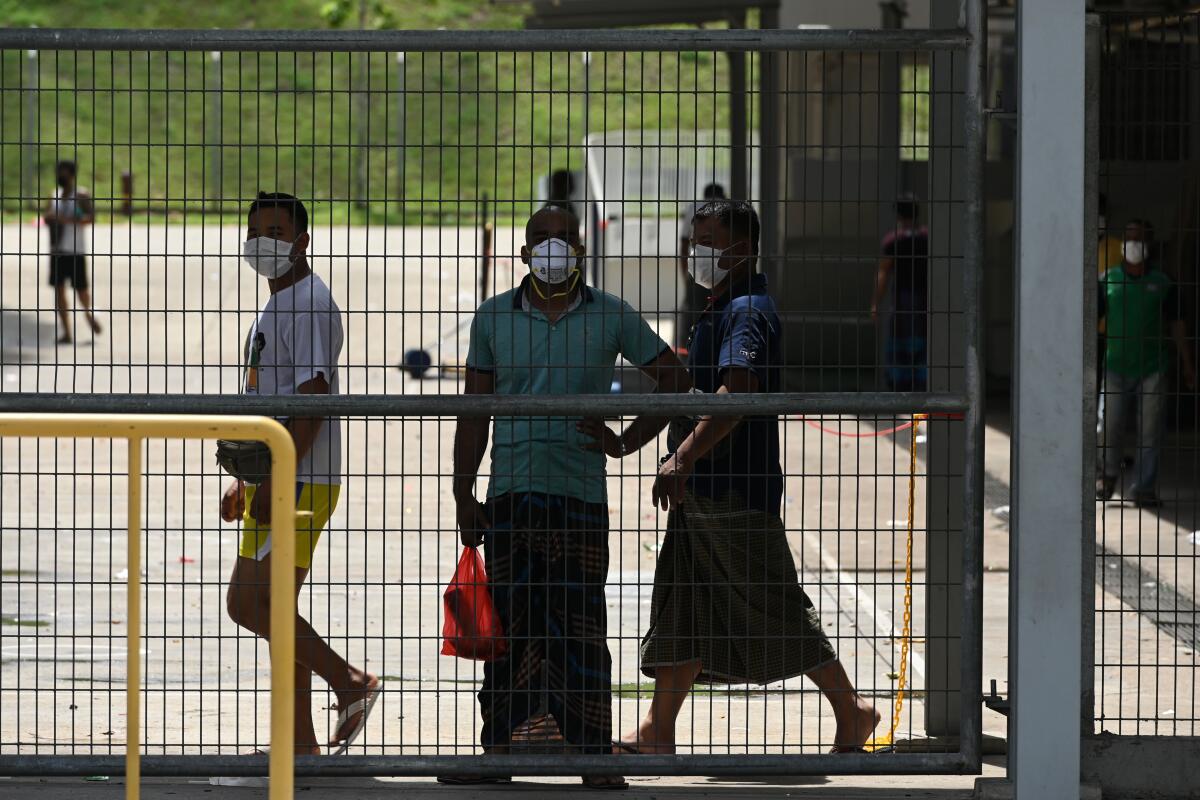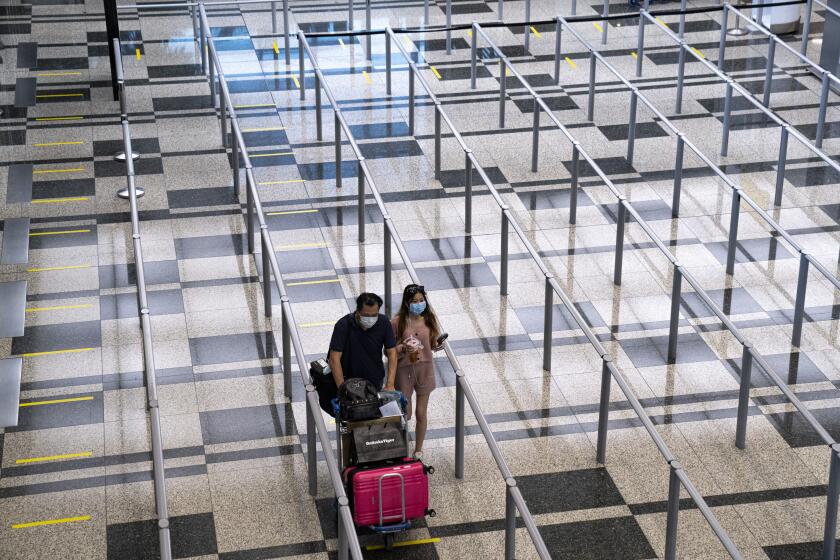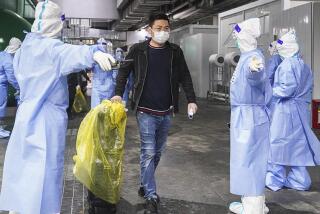From ‘gold standard’ to a coronavirus ‘explosion’: Singapore battles new outbreak

- Share via
SINGAPORE — Just weeks ago, Singapore was a coronavirus success story, admired for pinpointing infected patients and isolating their contacts with brisk efficiency, all while causing minimal disruption to an economy that was the envy of Asia.
But the island city-state is now battling to control an enormous outbreak spreading among a population that officials had mostly overlooked: the migrant workers who form the vast but unseen engine of Singapore’s prosperity.
The new wave of infections offers a stark illustration of the continued risks facing one of the world’s most densely inhabited regions — and of the coronavirus’ often disproportionate toll on the poor and marginalized.
COVID-19 cases in Singapore have tripled since the start of the month to more than 3,200, with most of the new infections found in laborers from India, Bangladesh and other countries who live in crowded, airless dormitories on the edges of the modern, manicured city-state they’ve helped build.
The dormitories — where workers often are made to sleep 20 to a room in bunk beds, share kitchens and bathrooms, and enjoy hardly any personal space — have allowed transmission of the coronavirus to explode. Singapore said Tuesday that it had quarantined eight dorms and would lock down dozens of others, effectively confining 200,000 workers to their rooms as authorities ramp up testing and isolate the infected.
“People are scared,” said Kiron, a 35-year-old construction worker from Bangladesh who lives in one of the dorms. He asked that his full name be withheld to protect his job. “You don’t know if you will be the next one to get sick.”

After avoiding a lockdown for months, and after Harvard researchers had praised Singapore as the “gold standard” in detecting new infections, the government last week closed schools and nonessential businesses and ordered residents to shelter indoors as much as possible. Infections had already begun to rise, and in recent days they’ve soared: On Monday, Singapore recorded an all-time high of 386 new COVID-19 cases, nearly all among migrant workers in dorms.
The crisis has laid bare the dizzyingly unequal conditions endured by Singapore’s army of 1 million imported, low-wage laborers who — not unlike farmworkers in California or construction crews in the Persian Gulf — make up a largely invisible underclass in this wealthy nation of 5.6 million.
“Singapore’s entire economic model is to reap the benefits of the cheap labor of the Third World in order to create our so-called First World economy,” said Alex Au, vice president of Transient Workers Count Too, an advocacy group that works on migrant labor issues.
“It worked fine when you could completely segregate them from Singapore society and house them in dormitories in far-out parts of the city. The only problem is a virus comes along that does not respect this apartheid-type of segregation, and then you have an explosion.”
Hired on short-term contracts with no chance at long-term residency or citizenship, about 500,000 migrants, mostly from South Asian countries, work on construction sites, assembly lines and shipyards. Most earn about $500 per month, according to activists, compared with more than $3,200 for the average Singaporean.
About 200,000 live in 43 purpose-built dormitories on the outskirts of the city, which is slightly larger than the San Fernando Valley. One of those dorms now has more than 700 coronavirus cases, one-fifth of the country’s total.
“They’re not often seen, or even if they are — when they’re cleaning our trash, building our buildings, gardening our parks — they’re kind of invisible,” said Laavanya Kathiravelu, an assistant professor at Singapore’s Nanyang Technological University who studies migrant labor. “When something like this happens, unfortunately, that’s when they become visible.”
TraceTogether’s app launch comes as concerns over privacy and intrusive surveillance are rising as governments try to curb the pandemic.
Singaporeans who returned from abroad last month were placed in 14-day isolation at luxury resorts, where rooms start at $300 a night, on the government’s dime. Before the lockdown, downtown office workers were subjected to strict temperature checks and rode elevators whose buttons were sprayed with disinfectant multiple times a day.
But the situation for migrant workers is far different.
On Friday, three days after the government lockdown began but well after the surge in infections among migrant workers, Rubel Arnab, a 30-year-old construction worker from Bangladesh, visited a dormitory in eastern Singapore to distribute masks and hand sanitizer donated by a local charity.
He found no one screening workers’ or visitors’ temperatures, and none of the leaflets promoting hygiene that are everywhere in the rest of Singapore. In one room filled with 10 bunk beds and a couple of small fans bolted to the roof, he found a dozen men sitting on the floor.
“There is no space,” Arnab said. “If one person is infected in the room, that means 19 others are going to be infected. Unless you reduce the numbers, there is no hope that a virus in the dormitories can be controlled.”
Singapore is now rushing to create distancing in the dorms. Officials said Tuesday they had moved 7,000 healthy workers into other temporary housing, including floating accommodations typically used by workers in offshore industries, vacant public housing blocks and bunks in parking structures.

There were warning signs before the new outbreak. On Feb. 10, after a Bangladeshi laborer became the first to be infected with the virus, lawyer Dipa Swaminathan, founder of It’s Raining Raincoats, an initiative that works with migrants, wrote a Facebook post warning that “the spread among them could be rapid, given the cramped conditions in which they live, work and are transported.”
Health officials said the man had visited Mustafa Center, a giant shopping complex in Singapore’s Little India district that is popular with foreign workers.
But as recently as two weeks ago, shoppers were going in and out of the building without temperature checks, and few employees were seen wearing masks. On Tuesday, the government said 86 infections had been linked to Mustafa Center.
In a national address last week, Prime Minister Lee Hsien Loong took the rare step of speaking directly to foreign workers and their families, saying that Singaporeans “appreciate the work and contribution of your sons, fathers and husbands” and “will do our best to take care of their health, livelihood and welfare here and to let them go home safe and sound to you.”
Lee promised that their salaries would be paid as usual and that the government would pay for treatment if they were infected.
But there is no plan, as of now, to house them in any of the mostly empty hotels across the city that were built with migrant labor.
“There is a certain amount of irony and sadness in that,” Swaminathan said. “Every beautiful condo, every plush hotel is built by them, and ironically now we are struggling to find space to segregate them while this virus rages through this community.”
More to Read
Sign up for Essential California
The most important California stories and recommendations in your inbox every morning.
You may occasionally receive promotional content from the Los Angeles Times.















